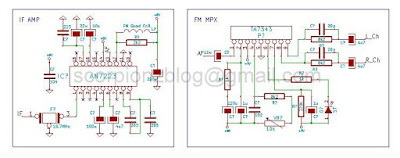 |
| Digital FM Receiver |
This is a simple stereo FM radio receiver circuit that can scan with 87.5 MHz and 108 MHz seamlessly between 100 kHz step and it use BK1080 as a receiver IC.
Main components of this receiver are a PIC16F88 micro-controller, 16x2 LCD and BK1080 FM receiver chip. This system is design to work with 5V DC power supply. User interface of this system consist with 6 push buttons and a 16×2 character LCD module. All the functions of this receiver can control by this buttons and necessary information displayed on the LCD.
Specifications of this receiver
- Easy to build
- Standby mode
- Automatic gain control
- Automatic frequency control
- Automatic noise suppression
- Preset memory stations up to 250 (default 20)
 |
| Schematic of BK1080 |
BK1080
The BK1080 FM receiver employs a low-IF architecture, mixed signal image rejection and all digital demodulation technology. The stations scan of BK1080 searches radio stations based on both the channel RSSI estimation and signal quality assessment, increases the number of receivable stations while avoids false stops. BK1080 enables FM radio reception with low power, small board space and minimum number of external components. All functions controlled through an I2C serial interface. See datasheet for more details.Numbers of memory locations are determine by the value of Eeprom 1 (default value 0x14).
You can connect an earphone directly with BK1080’s output. However, do not connect speakers directly with IC. I recommended you to use amplifier if you wish to get more sound. In addition, be carefully when soldering BK1080. Because this IC more sensitive to electrostatic. Use DC soldering Iron to solder this IC or unplug your iron when solder. Micro-controller runs using its internal oscillator. RA0 and RA1 are configuring as SCL and SDA. RA2 is not connected. RA6 pin can directly connect with background light of LCD display. As well as it is also can used for the controlling another device like mute pin of power amp.
Selecting the station:
When we are in the power on mode, on the screen we can see "Frq:107.5 Ch:12" - tuned frequency of the station and then the number of the cell where the recorded frequency of the station. Pressing ‘CH_UP’ and ‘CH_DN’ we can move the recorded stations. Pressing ‘FR_UP’ and ‘FR_DN’ we can change the frequency. ‘STORE’ stored the current frequency to the current station and ‘PWR’ used to toggle standby mode and power on mode
Firmware of this system was written by using MikroC for PIC and schematic, hex and Proteus files are available for download.
























